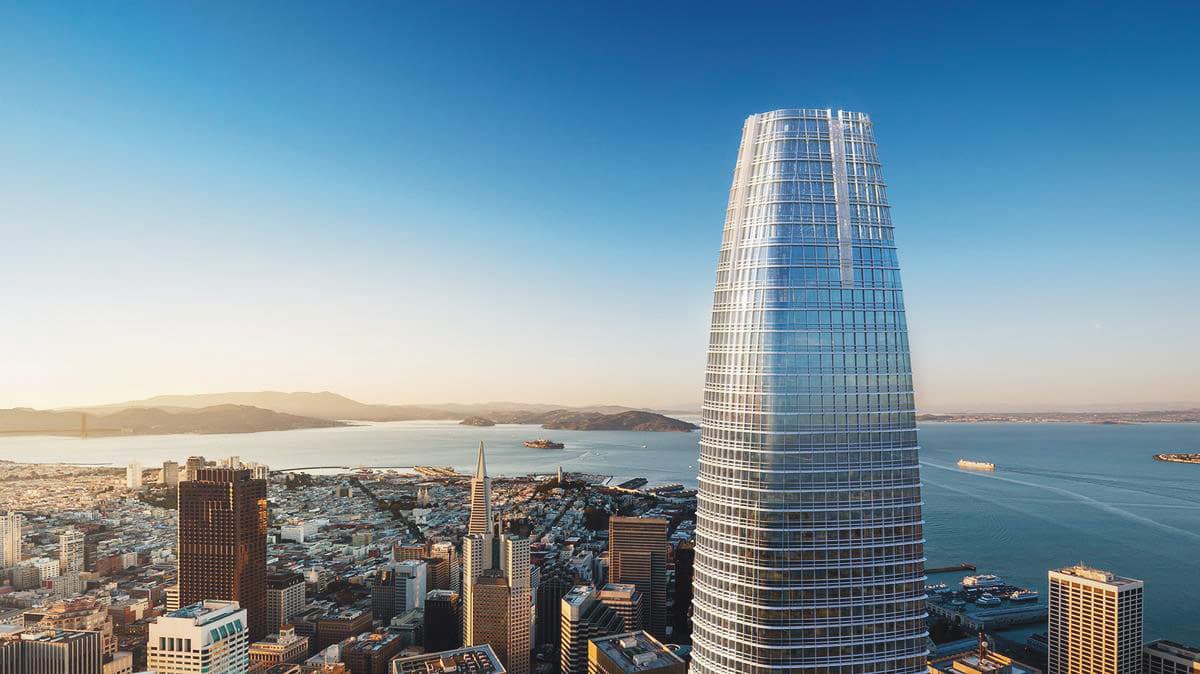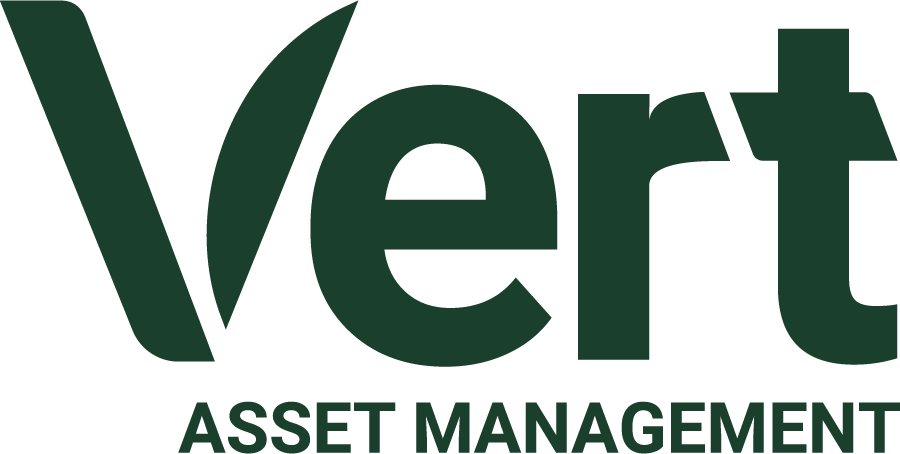Salesforce Tower
The Salesforce Tower is redefining San Francisco.
For nearly a half-century, the triangular shape of the iconic 853 ft. high Transamerica Pyramid defined the city’s skyline. The Salesforce Tower’s record breaking 1,070 feet is hard to miss. What people might not see is that the Salesforce Tower is also breaking new ground in sustainability.
Location
415 Mission St. South of Market District San Francisco, California
Height
1,070 feet – 61 stories*
Area
1.4 Million square feet*
Green Certification
LEED Platinum Certified
Breakthrough Innovation
Blackwater Recycling System
Owners
Boston Properties, Inc.1

Redefining San Francisco’s Urbanism
San Francisco is surrounded by water on three sides; the lack of available land constrains growth. The success of Silicon Valley has exacerbated the city’s decades long struggle with high occupancy rates and rents, and traffic. In an effort to alleviate this, and to plan for the future, San Francisco is trying to embrace an urbanism defined by density and public transportation. By building up, more people can live and work in the city. But more people create more demand for energy and water, and more transportation alternatives. The solution is sustainability.
Over 50% of the world’s population now lives in cities. Over the last 30 years, the trend towards cookie-cutter suburbs and long car commutes has started to reverse. More people want an urban lifestyle. City planners and developers around the world are turning towards building height as a way to keep more jobs and more residents near city centers. They also recognize the environmental and social challenges, and opportunities, that urbanism creates. Density reduces the cost of transporting goods and people. It can concentrate energy and water reduction technologies to serve more people and reduce traffic. The Salesforce Tower shows how the built environment can accomplish this.
Salesforce Tower is an integral component in the renovation of the Transbay Terminal in San Francisco’s South of Market. It is one of 13 buildings that will frame the new Transbay Transit Center, connecting SF to communities across the Bay Area through BART (Bay Area Rapid Transit), bus and rail.2
The original Transbay Terminal was built in the late 1930s for dedicated rail service. In the 1950s, the terminal adapted as buses replaced trains. By 2010, the building and area was in disrepair; it was reacquired by the city and subsequently demolished to build a more cohesive downtown area with transit, community, and jobs in mind. The city is hopeful that this new development connecting multi-modal transit, 13 new buildings and an elevated tree-lined public park will be the “Grand Central Station of the West.”
Sustainable Leadership
Boston Properties, Inc.3 a public REIT, co-developed the project with Hines, a private real estate investment and development firm, and the architecture firm Pelli Clarke Pelli who also designed the Transbay Transit Center.
Boston Properties primarily owns office buildings in five city centers across the US – Boston, New York, Washington D.C., San Francisco and Los Angeles. They are a leader in sustainability, ranking in the top quadrant of the Global Real Estate Sustainability Benchmark (GRESB) for each of the last six years.4
Salesforce.com, Inc. renamed the building (originally the Transbay Tower) after committing to leasing over half the building for 15 years. Salesforce is a Fortune 500 technology company with a strong commitment to sustainability and corporate responsibility. Recently achieving net-zero greenhouse gas emissions, they have also committed to a 100% renewable energy goal for their company.
New Frontiers in Energy and Water Efficiency
In collaboration with the City of San Francisco and Boston Properties, a blackwater recycling system will be installed in Salesforce Tower, making it the first partnership in the U.S. between a city government, a building owner and a tenant to support blackwater reuse in a commercial high-rise building. The system will provide water recycling capabilities for all tenants. The system will reduce the building’s drinkable water consumption by 76 percent, saving up to 30,000 gallons of fresh water a day, equivalent to the yearly water consumption of 16,000 San Francisco residents.5
The energy-efficient technologies installed are expected to reduce energy use by 35% compared to similar sized buildings. These technologies include a first of its kind HVAC system with air handlers on each floor that take advantage of the Bay Area’s temperate climate to use natural ventilation rather than air-conditioned air.6 This air economizer system cools the building interior with fresh air from outside, increasing air quality and lowering CO2. Low emission tinted glass and automated tilting blinds reduce solar heat gain.
How do these initiatives correspond to the sustainability metrics of the Vert Global Sustainable Real Estate Strategy?
The investment strategy for the Vert Global Sustainable Real Estate Fund uses a rules-based approach to evaluate the sustainability of a publicly-traded REIT. While the strategy does not evaluate individual buildings REIT, the Salesforce Tower has quite a few characteristics that can be highlighted as examples of our key performance indicators shown in the table below:
Key Performance Indicator
Salesforce Tower*
Energy Use and Greenhouse Gas Emissions Reduction
Energy Use reduction of 35%
7,040 Metric tons of CO2 equivalent emissions prevented
Green Building
The project is LEED Platinum Certified – Core and Shell
Stakeholder Engagement
The owner, Boston Properties, worked closely with city officials, with Salesforce, and others to maximize the positive impacts of this new building.
Climate Risk and Water Reduction
California is a high-drought risk state. The extreme droughts of 2006-2010 and 2012-2017 have reinforced the need to conserve water. Water recycling in the Salesforce Tower reduces 76% of the building’s water consumption, saving 7.8 Million gallons a year.
Urbanism and Public Transportation
Increases dwelling density as the tallest building in San Francisco
11 forms of public transportation into the Transbay Transit Center
*Multiple mentions of Salesforce Tower summary statistics including height and square footage are referenced from both:
Stok (2017) “Salesforce Tower.” Summary statistics. Available at: https://stok.com/salesforce-tower/
Hines (2017) “About Salesforce Tower.” Summary statistics. Available at: https://www.hines.com/properties/salesforce-tower-san-francisco
1 Boston Properties, Inc. is 3.57% of the Vert Global Sustainable Real Estate Fund (VGSRX) as of December 31, 2017.
2 Transbay Program. “Fact Sheets” Available at: http://tjpa.org/news-information/fact-sheets
3 Boston Properties, Inc. is 3.57% of the Vert Global Sustainable Real Estate Fund (VGSRX) as of December 31, 2017.
4 Boston Properties (2017) Investor Relations: Newsroom “Boston Properties Awarded Nareit’s 2017 Most Innovative Leader in the Light Award.” Available at: http://ir.bostonproperties.com/phoenix.zhtml?c=120176&p=irol-newsArticle&ID=2318215.
5 Salesforce (Jan 11, 2018). “A New Sustainability Milestone: Innovative Water Recycling System in Salesforce Tower.” Available at: https://www.salesforce.com/blog/2018/01/salesforce-tower-innovative-water-recycling-system.html
6 Salesforce Tower (2017) “HVAC System” Available at: http://www.salesforcetower.com/files/9013/9896/8459/Salesforce_Tower_HVAC_System.pdf
Please refer to the Prospectus for full risk disclosures. All data as of September December 31, 2017 and subject to change daily.
